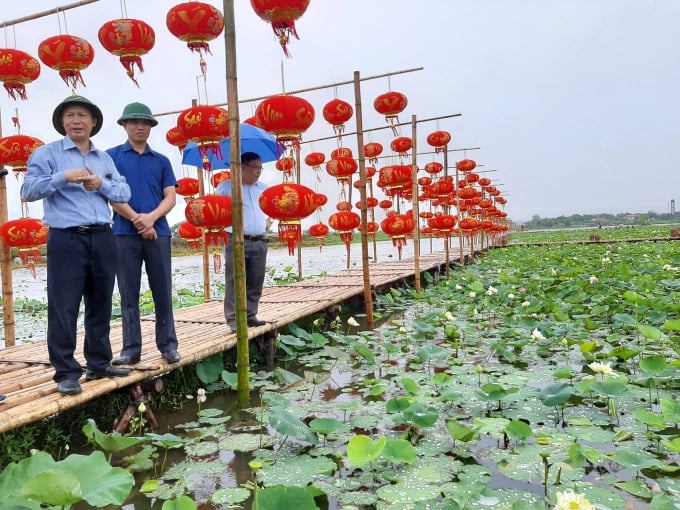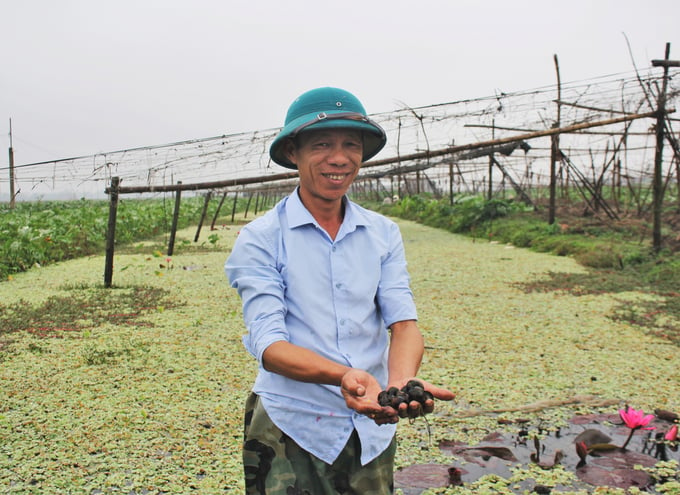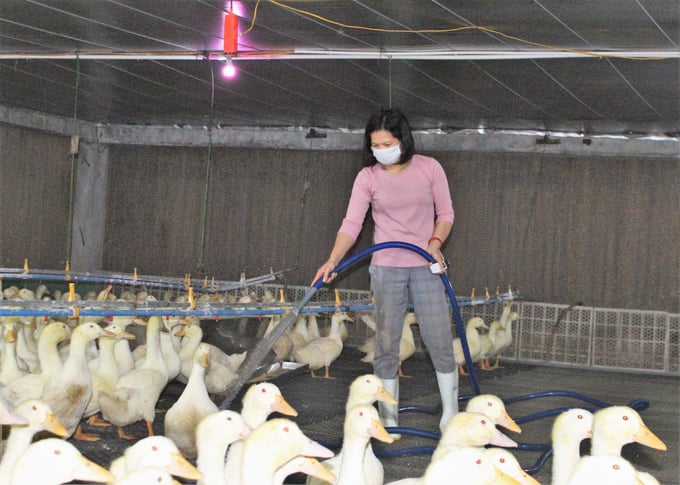Billion/Annual Income Conversion Models
In recent years, the implementation of agricultural sector restructuring in Ninh Binh province has brought about many positive changes. In the field of crop production, the restructuring in the direction of added value was accelerated; Converting inefficient rice and hill areas into high-quality agricultural production.

From the abandoned sunken fields, lotus trees have helped become a tourist attraction, drawing large numbers of visitors in Ninh Thang Township, Hoa Lu (Ninh Binh). Picture: Life.
According to the Ministry of Agriculture and Rural Development of Ninh Binh, the province converted about 6,000 hectares of inefficient rice land in 2016-2021. The forms of conversion are very diverse, e.g. B.: Conversion of rice land to the cultivation of annual crops (all kinds of vegetables such as zucchini, melon, cucumber, tomato, melon, melon, leafy greens…), production value is about 300-400 million VND/ha/year.
Converting rice land to growing perennial crops on dry land without taking the initiative to irrigate, planting a crop in Nho Quan district; Land for 2 paddy fields in Hoa Lu and Yen Khanh districts. The production value is from 230 to 800 million VND/ha/year.
Switching from simple rice cultivation to rice cultivation in combination with aquaculture, mainly focusing on 2 barefoot rice crops and 1 low-lying rice crops in Nho Quan, Gia Vien, Tam Diep and Hoa Lu districts. Aquaculture is traditional fish such as carp, common carp, locust, the production value reaches 200-450 million VND/ha/year.
Conversion from rice cultivation to other forms such as annual crops in combination with aquaculture; fruit trees combined with aquaculture; cultivation of lotus for tourism in combination with aquaculture; Aquaculture on floating ponds… This area is mainly located on the land of 2 paddy fields in Yen Mo, Kim Son, Hoa Lu and Tam Diep districts. The production value is 1-1.2 billion VND/ha/year, the profit is 450-500 million VND/ha/year.
Unique pattern “on the potato, under the snail”
Regarding Ninh Binh, today it is not difficult to see models of land accumulation, crop restructuring, changing forms of production for inefficient rice cultivation, and even the fallow land of agricultural contracts.Cooperatives, production households. From there, they help increase production value, profit and income, paving the way for sustainable agricultural development.
The field of Yen Thuong Village, Khanh Thinh Township (Yen Mo District) is naturally a low-lying field with mud and ash soil, so people cultivate rice inefficiently, the best harvest can only about 1.2-1.3 bring in quintals. When the costs are subtracted, there is no gain, not even a loss. Many households are therefore no longer interested in fields.
Before this fact, Mr. La Phu Thuan, Yen Thuong Village, Khanh Thinh Township, with the approval of the People’s Committee of Khanh Thinh Township, with a dream of becoming rich in his homeland, made a decision that many people joked about. “crazy” , when he left his job as a teacher, despite having worked in the industry for 25 years, he leased this land to develop the cultivation of sweet potatoes in combination with the rearing of stuffed snails.
Mr. Thuan shared: The total area he has rented from people is 4.2 hectares for nearly 40 households with a rental price of VND 1 million/sao/year. In June 2021, he was supported by the Ministry of Science and Technology of Ninh Binh with 5,000 sweet potato seedlings. This is a new variety of plant originating from Thailand with the same growing characteristics as Vietnam’s water potatoes. However, this potato variety has tall, strong leaves, has many economic prospects if it gives a higher yield and quality than many traditional varieties (tasty, crunchy, sweet and not sweet).

Converting inefficient rice land to growing sweet potatoes combined with raising stuffed snails has helped Mr. La Phu Thuan of Yen Thuong Village in Khanh Thinh ((Yen Mo) Township earn hundreds of millions of dongs a year. Trung Quan.
In addition, this potato variety is very suitable for slightly sunken fields, light soils, rich in humus. The tree has the ability to grow and develop very well with few pests and diseases, mainly leafworm and late blight. However, both of these diseases are easy to detect and manage with manual methods. All infected leaves should be removed and removed from the planting area for destruction. Therefore, crop protection work on potatoes involves less effort and cost compared to other vegetables.
In 2022, although it was the year of planting and soil improvement, he received 30 tons of raw bamboo shoots (the highest yield was 40-42 tons of raw bamboo shoots/year) with a selling price of 20,000 VND/kg pre-processing 35,000 VND/kg. He also sells the leaves to Hue and neighboring provinces at VND5,000/kg, and at the same time he can use the bad ships as fodder for snails, cattle, etc. If the economy is compared with agriculture, in the past , people’s previous rice production in the same area, its income was several times higher.
In addition, in 2022 he was supported by the Ninh Binh Center for Agriculture – Forestry – Fisheries Extension with 60,000 snails for breeding in combination with potato fields.
According to Mr. Nhuan, the combined breeding of snails in the potato field brings many advantages, both the use of a large area to quickly increase the flock (much better than raising snails in a tank) and the natural development of the snails. However, use the available resources and reduce costs.
In particular, the cultivation of potatoes and stuffed snails is not groundbreaking, since they mainly focus on improving the soil by creating low beds that can be immediately returned to use rice planting land if necessary. In addition, the combination of growing sweet potatoes and raising stuffed snails also creates favorable conditions for the development of production in a safe and organic direction. Because potatoes are used as vegetables, among them are snails and other natural resources such as crabs, shrimp, shrimp, snails… These are all very “picky” creatures of habitat, using chemical fertilizers and pesticides does not ensure food safety and will destroy the habitat of these organisms.
Therefore, before being fed to the agricultural sector, the water source must go through a settling tank and be treated with microbial products; The grooming process mainly uses rotted manure with probiotics and organic fertilizers for grooming.

Tran Van Canh, Duong Muoi Dong Village, Xuan Chinh Township (Kim Son)’s model of converting inefficient rice land to raise ducks into cold houses, with the order of 15,000 cows, brings about ten times more profit than that of ducks. Before. Picture: Trung Quan.
Mr. Nhuan calculated that although no snails were harvested, but with 600,000 supported parent snails, only 70% of the success is required (currently all snails are growing and developing healthily), this year is expected to add 20 tons of commercial snails 400-500,000 seeds. If you add up the income from growing sweet potatoes and raising stuffed snails, his income after expenses is up to hundreds of millions of dongs (much higher than traditional rice farming before).
According to Mr. Dinh Van Khiem, Deputy Director of the Ministry of Agriculture and Rural Development of Ninh Binh, in the coming period Ninh Binh’s agricultural sector will focus on the implementation of programs such as direction, by value chain; Development and improvement of the stature of farm animals towards meat specialization (cow, goat); Development of intensive agriculture of freshwater aquatic products, lowland aquatic products; develop shells; Development of a high-tech shrimp farm; Application of high technology in agriculture (science and technology), high technology for safe vegetable and fruit production; mechanization in production.
In addition, the province will continue to focus on promoting the transformation of cultivation patterns on inefficient rice-growing land. This is one of the most important programs prioritized by the agricultural sector to increase production value, profit and income for people; lay the foundation for building green, value-added and sustainable agriculture.

